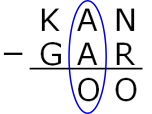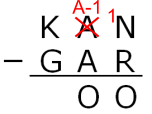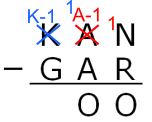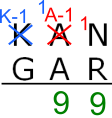Skip over navigation
Answer: KAN = 864 (and GAR = 765, OO = 99)
Using column subtraction

A $-$ A = zero but O shouldn't be zero, so there must have been 'borrowing'/'regrouping'


In $^1$A-1, 1 is the tens digit
A-1 is the units digit
(10 + (A-1)) $-$ A = O so O = 9

K$-$1 = G
$^1$N $-$ R = 9 means 10 + N $-$ R = 9 so R = N + 1
Largest possible KAN:
9 is taken so let K = 8 $\Rightarrow$ G = 7
A = 6
If N = 5 then R = 6 but 6 is taken
So N = 4 and R = 5
KAN = 864
Using algebra and logic
The difference between '$KAN$' and '$GAR$' is less than $100$ and since $K\neq G$ we must have $K=G+1$.
Next we must have $N < R$ else the difference between '$KAN$' and '$GAR$' would be at least $100$.
Let $R=N+x$ where $1< x< 9$. Then $OO=100-x$ and hence $O=9$ and $R=N+1$. Also we must have $K\leq 8$.
We want the largest value for $KAN$ so we try $K=8$. This forces $G=7$, hence must have $A\leq 6$. Set $A=6$, this forces $R\leq 5$ and hence $N\leq 4$ since $R=N+1$.
So $864$ is the largest possible value for $KAN$, and we have $864-765=99$.


Or search by topic
Number and algebra
Geometry and measure
Probability and statistics
Working mathematically
Advanced mathematics
For younger learners
Kangaroo Subtraction
Age 11 to 14
ShortChallenge Level 





- Problem
- Solutions
Answer: KAN = 864 (and GAR = 765, OO = 99)
Using column subtraction

A $-$ A = zero but O shouldn't be zero, so there must have been 'borrowing'/'regrouping'


In $^1$A-1, 1 is the tens digit
A-1 is the units digit
(10 + (A-1)) $-$ A = O so O = 9

K$-$1 = G
$^1$N $-$ R = 9 means 10 + N $-$ R = 9 so R = N + 1
Largest possible KAN:
9 is taken so let K = 8 $\Rightarrow$ G = 7
A = 6
If N = 5 then R = 6 but 6 is taken
So N = 4 and R = 5
KAN = 864
Using algebra and logic
The difference between '$KAN$' and '$GAR$' is less than $100$ and since $K\neq G$ we must have $K=G+1$.
Next we must have $N < R$ else the difference between '$KAN$' and '$GAR$' would be at least $100$.
Let $R=N+x$ where $1< x< 9$. Then $OO=100-x$ and hence $O=9$ and $R=N+1$. Also we must have $K\leq 8$.
We want the largest value for $KAN$ so we try $K=8$. This forces $G=7$, hence must have $A\leq 6$. Set $A=6$, this forces $R\leq 5$ and hence $N\leq 4$ since $R=N+1$.
So $864$ is the largest possible value for $KAN$, and we have $864-765=99$.
This problem is taken from the UKMT Mathematical Challenges.
You can find more short problems, arranged by curriculum topic, in our short problems collection.
You may also like
Consecutive Numbers
An investigation involving adding and subtracting sets of consecutive numbers. Lots to find out, lots to explore.
Days and Dates
Investigate how you can work out what day of the week your birthday will be on next year, and the year after...

